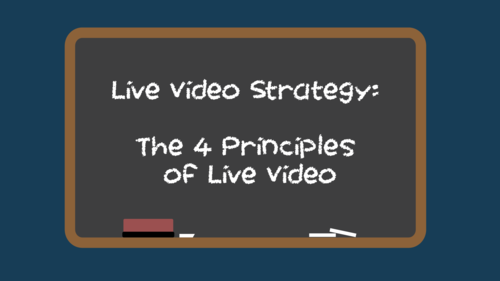by Daniel Kleinkopf
Live video – like all content marketing – requires strategy.
While live can be a highly efficient format for content teams, it’s not as simple as tapping a record button and going live.
Clarifying your objectives, matching content to those objectives, and planning and execution all figure into a successful live strategy.
Though different organizations may seek different outcomes with live, there remain key insights that characterize any successful approach to live video.
Here are the 4 principles of live video:
1. Be Prepared
Preparation refers to both your content as well as your technical setup.
Live video is about capturing the moment. But to do so effectively and credibly, you need to know what you’re talking about.
Having a good grasp of your subject matter as well as an idea of your run of show (i.e., an outline of your broadcast) can lend order to your broadcast – not to mention, calm your nerves.
Preparing talking points, prefab lines, or other planned elements can also relieve you from the pressure – and risk – of being 100% spontaneous.
Technical prep-work is also crucial.
Make sure to run some tests with the exact equipment and in the exact environment you plan to use. Internet, especially WiFi, is unpredictable. Run a test stream without any distribution points and check the performance.
Pro tip: Kill two birds with one stone by combining your technical test with a dry run of your show.
2. Be Consistent
As with content marketing generally, your live video output should follow a regular cadence.
To build an audience of followers, it helps to inject predictability into your content calendar.
Whether you choose to go live once a month, once a week, or even daily, consistency helps set expectations around when your audience can consume new content.
Individual live broadcasts may not produce viral moments.
However, in the cumulative, they can help your brand attract new viewers, while also enabling you to humanize your brand, shape critical conversations, and engage important stakeholders over the long term.
3. Be Authentic
Two qualities make live video the most powerful format on digital platforms:
> First, its ability to unlock real-time audience engagement
> Second, its unique ability to communicate authenticity
In 2019, consumers are savvier and more skeptical than ever and increasingly tune out the slick, overly produced content of yesteryear.
At the same time, content consumption has migrated to mobile devices and social platforms, giving momentum to a new, more human aesthetic in video content.
Both of those developments point to the power of authenticity.
Authentic content – meaning, video content that feels less manicured and more human, direct, and immediate – is more likely to be consumed and engaged with, because it matches the prevailing mood of consumers as well as their viewing habits.
But, more, authentic content unlocks new opportunities for brands to build trust with consumers, humanize themselves, and generate greater affinity.
Practically, what does that mean? In a nutshell: Keep it real.
Don’t be afraid of being imperfect in your live broadcasts. On the contrary, embrace authenticity – the real way that people talk (ums and ahs and all), a natural visual aesthetic, and so on.
4. Be Flexible
Live video is, well, live.
Everything doesn’t always go according to plan. A guest may no-show or cancel late, a team member may forget to display a graphic, you may need to jump back to a point you forgot to mention, and on and on.
Similarly, new opportunities may arise during a live broadcast that you didn’t expect. You may think of a new idea while you’re live, or you may receive a viewer comment that allows you to take a conversation in an illuminating new direction.
It’s important to roll with the punches – or, more optimistically, to go with the flow.
The dividends you receive from authenticity – and responding to real moments in real time – far outweigh the perceived costs associated with broadcasts that are less than perfect.
That doesn’t mean you shouldn’t plan for contingencies. But no matter what comes your way, trust your instincts and do your best to make the best of every broadcast.
The 4 principles above offer a solid foundation upon which you can build your live video strategy.
Remember to treat live video as an extension of your content marketing – a format that deserves the same kind of planning and deliberation you use for thought pieces, regular video content, and so on.
When you pair live video content with a strong strategy, you can realize the full potential of the web’s most powerful content format.

